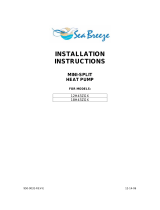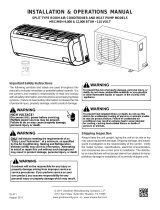
Satety precautions
03
Safety precautions
This appliance must be installed by a qualified licensed HVAC
technician in accordance with all applicable codes. All electrical
connections should be performed by a licensed electrician.
Manufacturer's warranty will be voided with failure to comply.
Incorrect Handling cound result in Serious Injury or Death!
1. Do not attempt to install the split air
conditioner by yourself.
2. This air conditioner contains no
user-serviceable parts. Always call
an authorized Electrolux servicer
for repairs.
3. When moving the air conditioner,
always call an authorized Frigidaire
servicer for disconnection and re-
installation.
4. Do not insert fingers or place
objects into the discharge area in
the front of the indoor unit.
5. Do not insert fingers or place
objects into the discharge area in
the front of the outdoor unit.
6. Do not start or stop the air
conditioner by turning off the power
at the electrical box.
7. In the event of a malfunction (sparks,
burning smell, etc.) immediately
power off unit and call an
authorized Frigidaire servicer.
8. Do not operate the air conditioner
with wet hands.
9. Do not drink any water or
condensation that is drained from
the air conditioner.
10
.Provide occasional ventilation
during use. Do not direct airflow
at fire places or other heat related
sources as this could cause flare
ups or make units run excessively.
11. Do not climb on or place objects
on the outdoor unit.
12. Do not hang objects off the indoor
unit.
13. Do not place objects containing
water on the indoor and/or
outdoor units.
14. Turn off the air conditioner at the
power source when it will not be
used for an extended period of
time.
15. Periodically check the condition of
the outdoor unit’s installation base
for any damage.
16. Do not apply heavy pressure to
the coil fins of the indoor and/or
outdoor units.
17. Operate the indoor unit with air
filters in place.
18. Do not block or cover the intake
grille, discharge area and outlet
ports.
19. Ensure that any electrical/
electronic equipment is 36” away
from the indoor unit and outdoor
unit.
20. Do not use or store flammable
gases near the indoor and/or
outdoor units.





















